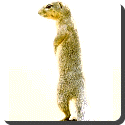 Gopher — A gopher is a small burrowing rodent.
Gopher — A gopher is a small burrowing rodent.
All gophers have in common the digging of tunnels and subterranean chambers and the traits associated with the rodent order, Rodentia. Disruption of such human plans for the surface as commercial agriculture, garden plots, and some landscaping, by their underground activities, leads to their frequent treatment as pests. In contrast, North American entertainment culture and non-technical literature tends to anthropomorphize gopher characters as non-threatening, if perhaps rascally, figures.
Gophers are notably much smaller than ground hogs in many ways. For example: Weight .5lbs, Head and Body 6 inches, Tail 3 inches, and 2-3 year lifespan. The mythology of the largely disappeared American prairie, while often distinguishing the prairie dog from gophers, accords the prairie dog a niche as the romantic small-animal symbol of the prairie.
The pocket gophers are burrowing rodents of the family Geomyidae. These are the “true” gophers, though several ground squirrels of the family Sciuridae are often called gophers as well. The name “pocket gopher” on its own may be used to refer to any of a number of subspecies of the family. Pocket gophers, despite being largely a pest, are a symbol of the U.S. state of Minnesota, sometimes called the “Gopher State”.
Pocket gophers are widely distributed in North America, extending into Central America.
Gophers are heavily built, and most are moderately large, ranging from 12 to 30 centimetres in length, and weighing a few hundred grams. A few species reach weights approaching 1 kg. Males are always larger than the females and can be nearly double their weight. Most gophers have brown fur which often closely matches the color of the soil in which they live. Their most characteristic feature is their large cheek pouches, from which the word “pocket” in their name derives. These pouches are fur-lined, and can be turned inside out. They extend from the side of the mouth well back onto the shoulders. They have small eyes and a short, hairy tail which they use to feel around tunnels when they walk backwards.
All pocket gophers are burrowers. They are larder hoarders, and their cheek pouches are used for transporting food back to their burrows. Gophers can collect large hoards. Their presence is unambiguously announced by the appearance of mounds of fresh dirt about 20 cm in diameter. These mounds will often appear in vegetable gardens, lawns, or farms, as gophers like moist soil. They also enjoy feeding on vegetables. For this reason, some species are considered agricultural pests. They may also damage trees in forests. Although they will attempt to flee when threatened, they may attack other animals, including cats and humans, and can inflict serious bites with their long, sharp teeth.
Pocket gophers are solitary outside of the breeding season, aggressively maintaining territories that vary in size depending on the resources available. Males and females may share some burrows and nesting chambers if their territories border each other, but in general, each pocket gopher inhabits its own individual tunnel system.
Depending on the species and local conditions, pocket gophers may have a specific annual breeding season, or may breed repeatedly through the year. Each litter typically consists of two to five young, although this may be much higher in some species. The young are born blind and helpless, and are weaned at around forty days.
 Kids Portal For Parents India Kids Network
Kids Portal For Parents India Kids Network






